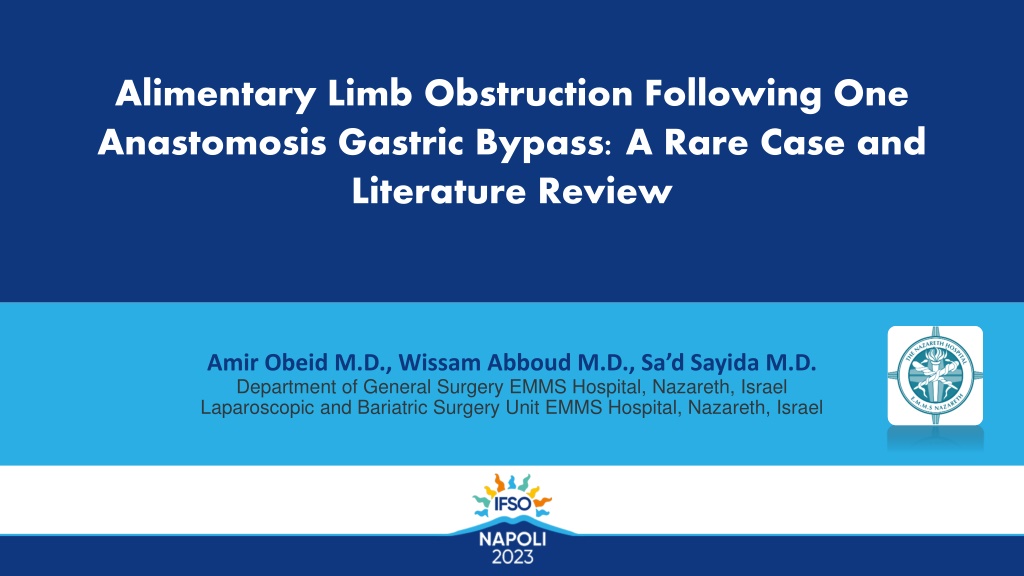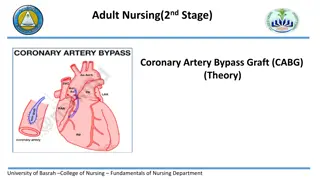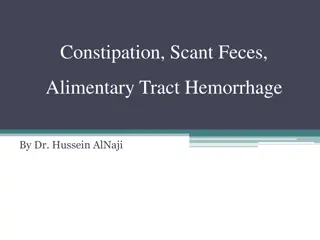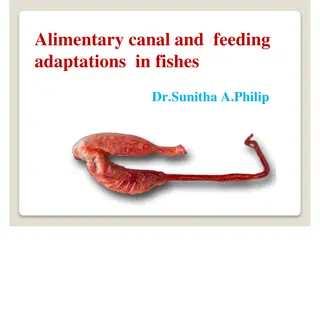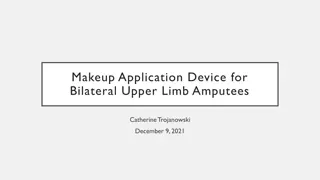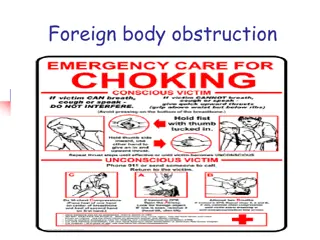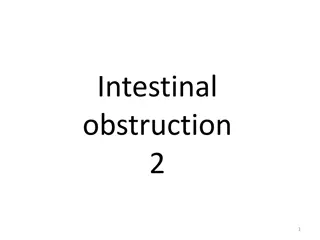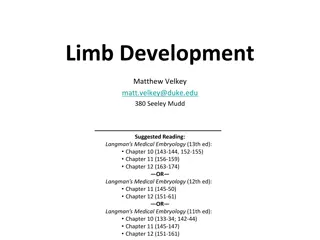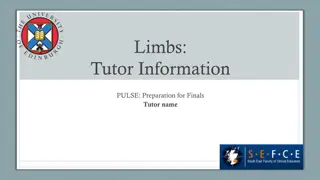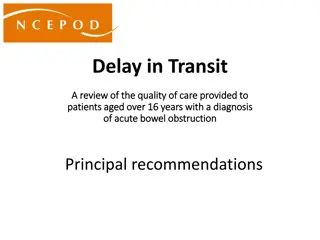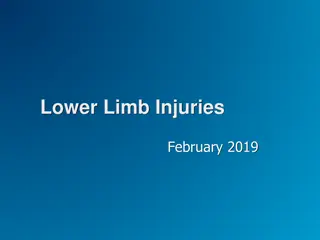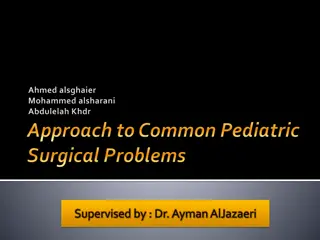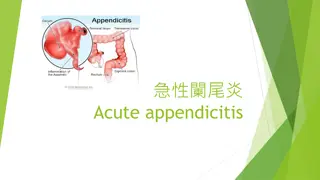Alimentary Limb Obstruction Following Gastric Bypass: A Rare Case and Review
Advances in bariatric surgery techniques have led to successful outcomes, but complications like bowel obstruction can still occur. This case report highlights a rare instance of alimentary limb obstruction post bariatric surgery, emphasizing the importance of early diagnosis and management.
Download Presentation

Please find below an Image/Link to download the presentation.
The content on the website is provided AS IS for your information and personal use only. It may not be sold, licensed, or shared on other websites without obtaining consent from the author. Download presentation by click this link. If you encounter any issues during the download, it is possible that the publisher has removed the file from their server.
E N D
Presentation Transcript
Alimentary Limb Obstruction Following One Anastomosis Gastric Bypass: A Rare Case and Literature Review Amir Obeid M.D., Wissam Abboud M.D., Sa d Sayida M.D. Department of General Surgery EMMS Hospital, Nazareth, Israel Laparoscopic and Bariatric Surgery Unit EMMS Hospital, Nazareth, Israel
CONFLICT OF INTEREST DISCLOSURE CONFLICT OF INTEREST DISCLOSURE In accordance with EACCME criteria for the Accreditation of Live Educational Events I have no potential conflict of interest to report
CASE MIX DISCLOSURE Types of Bariatric Surgeries 2022-2023 Conversion to Roux en Y from Sleeve Gastrectomy (30) 18% Mini Gastric Bypass (90) 55% Sleeve Gastrectomy (10) 6% Mini Gastric Bypass (90) Roux en Y (35) Roux en Y (35) 21% Sleeve Gastrectomy (10) Conversion to Roux en Y from Sleeve Gastrectomy (30)
Background Advances in surgical techniques and technology especially in bariatric surgery are an ongoing process which have enabled surgeons to achieve operative success and satisfaction for morbidly obese patients undergoing these procedures. Incidence of complications remains an issue for many surgeons which may have consequences postoperatively, abdominal symptoms following laparoscopic bariatric surgery remain a challenge for the surgeon in obtaining a definite diagnosis. Various complications can lead to post-op abdominal pain which cause gastrointestinal impairment, such as, bowel obstruction which has been seen following Roux-en-Y gastric bypass.
Objectives We report a rare case of bowel obstruction of alimentary limb following OAGB as a result of a V- loc suture which grasped and obstructed the alimentary limb causing obstruction and chronic abdominal complaints. After literature review, to date, only a few descriptions of obstruction following Roux-en-Y have been reported which verifies the incidence in bariatric procedures. The aim of the study was to review our experience of bowel obstruction due to V-loc suture following bariatric surgery and compare the outcomes with other cases.
Case Report The patient is a 43-year-old woman who underwent a mini gastric bypass procedure 2 years prior to 2023 for weight loss. She also had a cholecystectomy 1 year prior to 2023. She presented to the emergency department with complaints of abdominal pain and vomiting that had been ongoing for several days. The patient had multiple ER visits for similar complaints in the past. On admission, the patient's vital signs were within normal limits. Physical examination revealed abdominal tenderness, but no signs of peritonitis. Routine blood tests, including blood gases, were all within normal limits. Due to ongoing complaints and numerous admissions to the ER to further diagnose the pathology an abdominal CT scan with contrast was performed which showed suspicious signs of an internal hernia causing small bowel obstruction.
Case Report The patient was taken to an emergent diagnostic laparoscopy. The patient underwent emergent diagnostic laparoscopy, which revealed that the alimentary limb following mini gastric bypass surgery was obstructed by a V-loc grasped and obstructed the limb. suture, which had The obstruction and adhesions were released, and the operation was concluded without complications. The patient was monitored postoperatively and discharged on postoperative day 2. Follow-up visits showed that the patient had no further complaints of abdominal pain or vomiting.
Outcome The patient was monitored postoperatively and discharged on postoperative day 2. Follow-up visits showed that the patient had no further complaints of abdominal pain or vomiting. After literature review, to our knowledge, only five cases of obstruction caused by V-loc sutures following gastric bypass has been reported which verifies the minimal incidence in bariatric-metabolic surgeries.
Discussion Internal hernias are a rare but serious complication of gastric bypass surgery, with an incidence ranging from 0.2% to 9%. They can occur at various sites, including mesenteric defects, Petersen's space, and jejuno- jejunal anastomosis. CT scan with contrast is a useful diagnostic tool for internal hernias, with reported sensitivity and specificity of 92% and 95%, respectively. The patient in this case had a V-loc surgery, which can lead to the formation of internal hernias. Few studies have reported an increased risk of internal hernias with the use of V-loc sutures in gastric bypass surgery compared to non-absorbable sutures. (1,2) A retrospective study also showed that the use of V-loc significantly higher risk of internal hernias. (3) suture obstructing the alimentary limb following mini gastric bypass sutures was associated with a References: 1. Stenberg E, Szabo E, gren G, Ottosson J, Marsk R, L nroth H, N slund I. Internal hernia after gastric bypass: a new and simplified technique for laparoscopic primary closure of the mesenteric defects. JSLS. 2014 Oct-Dec;18(4):e2014.00226. doi: 10.4293/JSLS.2014.00226. PMID: 25593608; PMCID: PMC4305297. Enochs WS, Boggs JW. Internal Hernias. StatPearls [Internet]. Treasure Island (FL): StatPearls Publishing; 2022 Jan-. PMID: 29083767. Alshammari AS, Alshammari MS, Alshammari TM, AlShammari MA, Almuhaidib FM, Alasmari HS. Internal Herniation Following Laparoscopic Roux-en-Y Gastric Bypass: A Case Series of a Rare Complication. Cureus. 2021 Apr 6;13(4):e14349. doi: 10.7759/cureus.14349. PMID: 33987027; PMCID: PMC8110899. 2. 3.
Conclusion Despite advancements in bariatric-metabolic surgery, complications remain an issue for many surgeons, and abdominal symptoms following laparoscopic bariatric surgery continue to be a challenge in obtaining a definite diagnosis. This review underscores the importance of considering internal hernias as a potential cause of recurrent symptoms in patients with a history of bariatric surgery. Overall, this study adds to the existing body of literature on complications in bariatric-metabolic surgery and highlights the importance of ongoing research and innovation in this field. The report also emphasizes the value in identifying rare cases and enhancing our understanding of the potential risks associated with surgical procedures.
